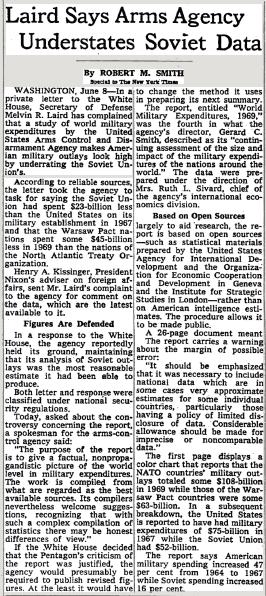Ruth Leger Sivard's |
||
 |
|
Home___Publications___Background___Contact |
|||

From the New York Times June 9, 1970:
Laird Says Arms Agency Understates Soviet Data
by Robert M. Smith
In a private letter to the White House, Secretary of Defense Melvin R. Laird has complained that a study of world military expenditures by the United States Arms Control and Disarmament Agency makes American military outlays look high by underrating the Soviet Union's.
According to reliable sources the letter took the agency to task for saying the Soviet Union had spent $23-billion less than the United States on its military establishment in 1967 and that the Warsaw Pact nations spent some $45-billion less in 1969 than the nations of the North Atlantic Treaty Organization.
Henry A. Kissinger, President Nixon's adviser on foreign affairs, sent Mr. Laird's complaint to the agency for comment on the data, which are the latest available to it.
Figures are Defended
In a response to the White House, the agency reportedly held its ground, maintaining that its analysis of Soviet outlays was the most reasonable estimate it had been able to produce.
Both letter and response were classified under national security regulations.
Today, asked about the controversy concerning the report, a spokesman for the arms-control agency said:
"The purpose of the report is to give a factual, nonpropagandistic picture of the world level in military expenditures. The work is compiled from what is regarded as the best available sources.Its compilers nevertheless welcome suggestions, recognizing that with such a complex compilation of statistics there may be honest differences of view."
If the White House decided that the Pentagon's criticism of the report was justified, the agency would presumably be required to publish revised figures. At least it would have to change the method it uses in preparing its next summary.
The report, entitled World Military Expenditures, 1969 was the fourth in what the agency's director, Gerard C. Smith, described as its "continuing assessment of the size and impact of the military expenditures of the nations around the world." The data were prepared under the direction of Mrs. Ruth L. Sivard, chief of the agency's international economics division.
Based on Open Sources
Largely to aid research, the report is based on open sources - such as statistical materials prepared by the United States Agency for International Development, and the Organization for Economic Cooperation and Development in Geneva, and the Institute for Strategic Studies in London - rather than on American intelligence estimates. This procedure allows it to be made public.
A 26-page document, the report carries a warning about the margin of possible error:
"It should be emphasized that it was necessary to include national data which are in some cases very approximate estimates for some individual countries, particularly those having a history of limited disclosure of data. Considerable allowance should be made for imprecise or noncomparable data."
The first page displays a color chart that reports that the NATO countries' military outlays totaled some $108-billion in 1969 while those of the Warsaw Pact countries were some $68-billion. In a subsequent breakdown, the United States is reported to have had military expenditures of $75-billion in 1967 while the Soviet Union had $52-billion.
The report says American military spending increased 47 per cent from 1964 to 1967 while the Soviet spending increased 16 per cent.